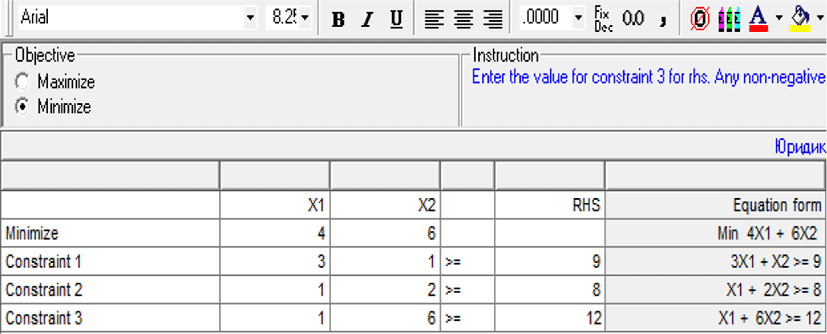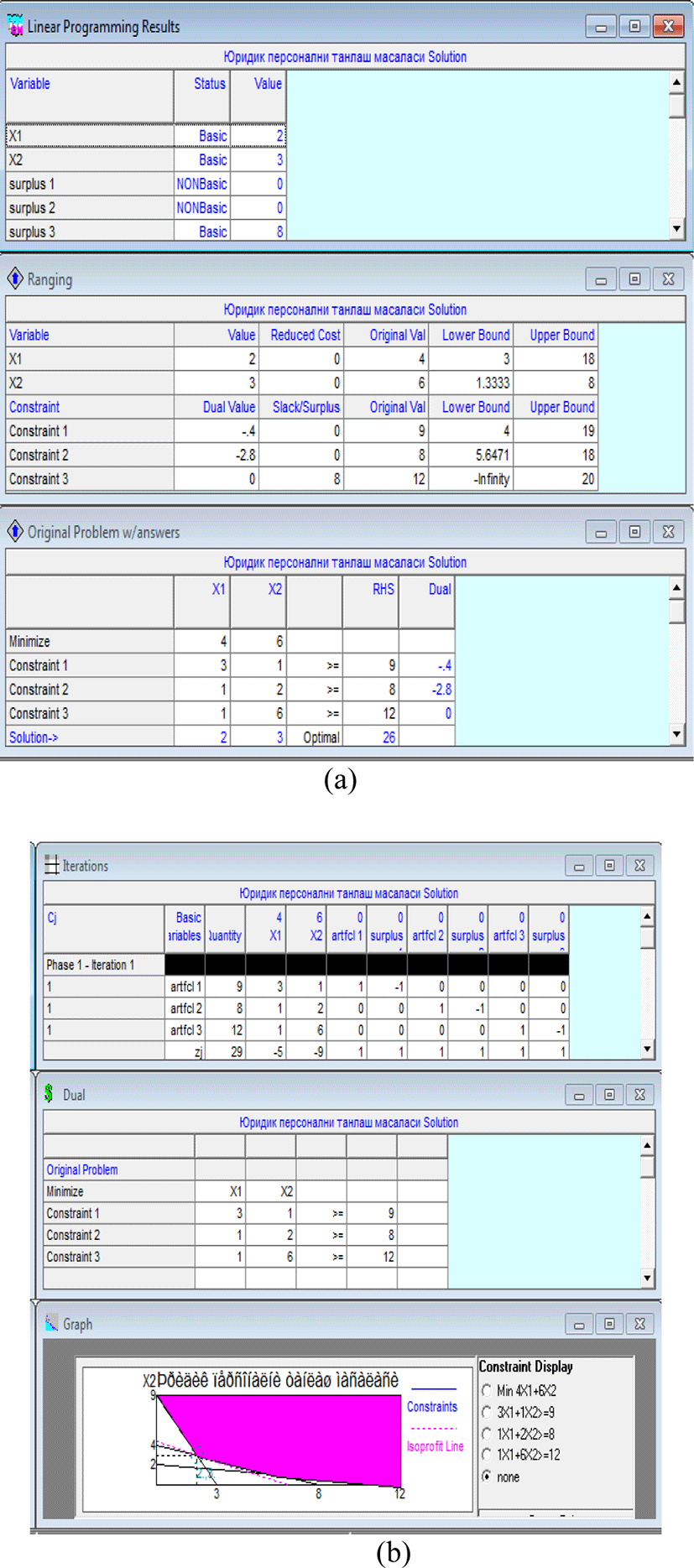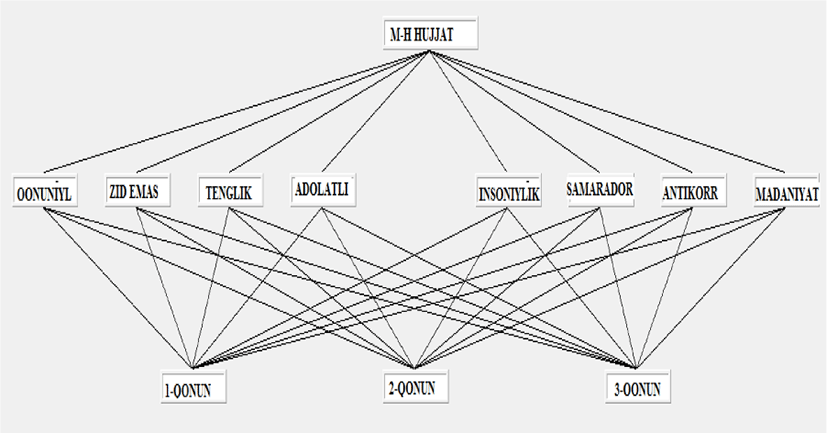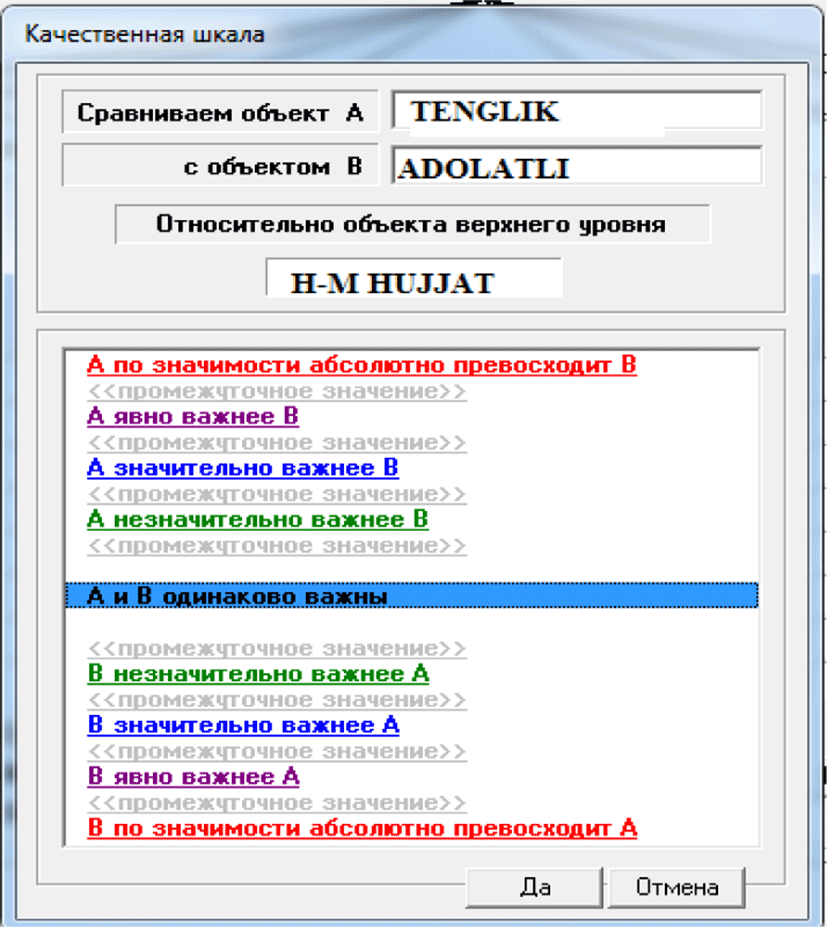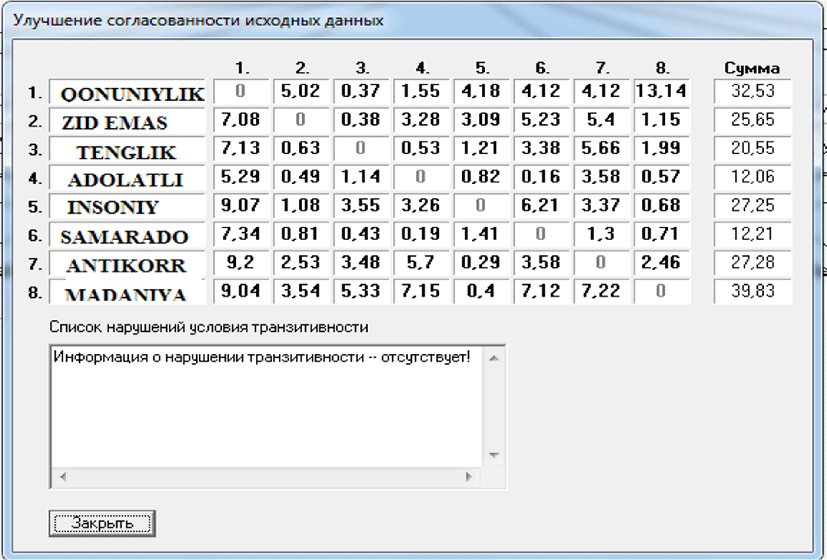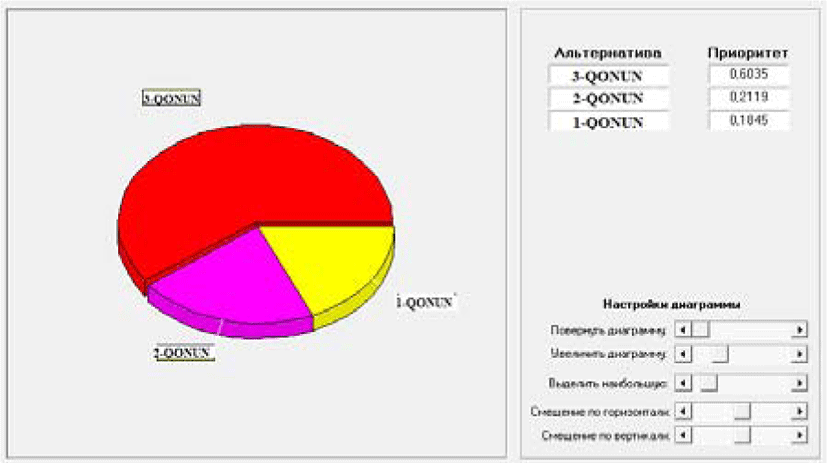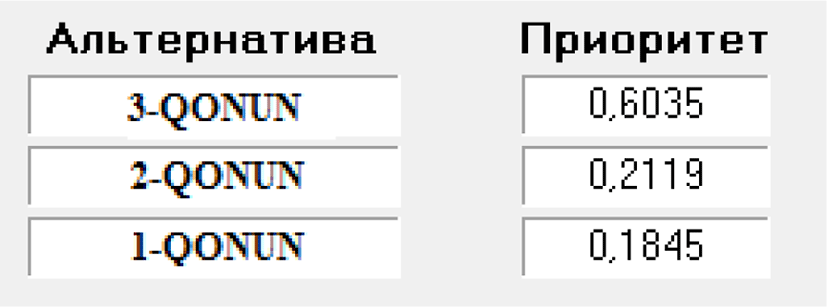I. INTRODUCTION
Everybody at least once during his life makes an important decision. Observations show that the person makes about 1500 different decisions a day. Surely, we can conclude that to some extent, each of us is an owner of the situation, the decision maker at a pivotal point of his life. When the decision affects subsequent matters or future state, one should think about what responsibility each decision carries.
In the market economy, naturally, the customer is a king – currently, labor market demands not just lawyers, but specialists who can make decisions based on evaluation of internal and external conditions. Also, it is paramount to have firm experience or subject knowledge when making decisions.
II. STATEMENT OF A PROBLEM
The Tashkent State Institute of law in 2013 year was transformed into the Tashkent State University of Law. This mandates University graduates to become not only professional lawyers. Multifaceted face of current workplace dictates that modern professionals must assess different factors, evaluate various outcomes and be efficient in different fields. The lawyers should not judge situation only based on codes or statues, they must take into account other values as well to come to effective solutions to problems.
What are the challenges facing lawyers? On this question, I think a better answer comes from the lawyers themselves. Let’s take, for instance, decision on the adoption of a legislative act. If a person with a legal background evaluates it with such features like the legality, validity, the relationship with other laws and regulations, the decision maker must take into account the implications of this decision, as a financial expert he must consider the capital costs or similar, and as the psychologist one should also take into account the mentality and social aspects and etc.
Decision-making is rather important moment not only for leaders, but also for those who are around them. The process of searching for alternatives is a time consuming process. Today's rate of information technologies and computer aided process simulation development are just too demanding on time. We are always behind on time scale. So what route should leaders take, to squeeze even more and overcome time deficit?
There is and increasing demand for systems which would come to the assistance of decision makers and that not only provide information but could also perform some preliminary analysis of the task, give some tips and tricks to finding a solution, make predictions for a specific time period, and select the most effective and optimal alternatives presented. In other words, these systems should facilitate and support the decisions of the leaders, taking over a part of routine operations.
III. THE CONCEPT OF THE PROBLEM DECISION
On the nature the legal problems can be directed to the receipt of any instructions or regulations to address the problem-legal situations. Legal tasks can be divided according to certain criteria. For the purposes they can be lawmaking, that is aimed at filling the existing legislation; forecasting, analysis of the risks of legal action; law-providing, which is aimed at obtaining resources for specific purposes; concrete legal norms in a narrow scope of legal activity; law-organizing, which are aimed at streamlining the organization and activity of the lawyer; legalization, which are aimed at legalizing the legal solutions to ensure their fairness and effectiveness.
The decisions of these legal challenges are the legal assessment of the actual composition of the event; evaluation, validation and authentication of information; assessment of conformity with the law of the decision; finding contradictions or objections to requirements; definition of possible behavior in certain situations, etc. These are the tasks and actions most frequently deciding by lawyers. These kinds of tasks intertwine in a certain area, and in more cases the decision may be the same. That shows that legal challenges can be structured and has algorithms of actions in many spheres of law. [6]
The development of information technology has given us such solution. These intelligent information systems support the leaders in making optimal decisions that bond intellectual resources of a human leader with abilities of computer in order to improve the quality of decisions. Intelligent information systems help decision makers to accelerate analysis of external factors such as economic, political, technical, and social aspects, take into account the limited resources and optimally allocate such a valuable resource as time.
What tasks are solved by intellectual information systems? The tasks related to data interpretation, diagnosis, monitoring, planning, forecasting and training. As a solution for future graduates not only in law but also in other fields let me offer QM software package for Windows. This tool is very popular in the United States, Mexico, and Thailand. I’d like to see it used extensively by leaders in our country as well, by all those who are interested in best decision outcomes. This program solves the following types of tasks and can become the best assistant in locating optimum decisions: assignment task, cost-benefit analysis, decision analysis, linear programming, inventory, market analysis, material requirements planning, project management (PERT/CPM), quality control, simulation, statistics, transportation, waiting lines.
Which of these kinds of tasks are related to decision makers in legal field? I think that the use of this program to meet the challenges of appointments, forecasting, planning, resource requirements, and project management can be directly associated with decision making in the legal field.
The following software product can also be useful for legal specialists. MPriority is a program that is designed for tasks such as a selection of the best business partners according to the criteria, the profitable allocation of business income, assignment tasks, that is, selection of the best candidates for the jobs, selection of the best strategies and many more. All the above also exist not only in private, but in public institutions, so the application scope is quite large for the abovementioned software tool.
IV. REALIZATION OF THE CONCEPT
I would like to give an example of a task from the legal sphere, so we can see how to apply this program. At the same time, I wish to point out that a mathematical model of the problem plays an important role in making decisions with the help of these programs. For the correct compilation of the mathematical model of the problem, identification of data model using mathematical expressions guarantee optimal solutions using smart information systems.
-
When selecting staff consisting of two legal specializations, we take into account the minimum demand for three types of customers.
-
The number of clients required for a unit of personnel is given in the table.
-
The salary of each lawyer 4000 and 6000 Euros.
-
You must select a staff whose salary costs will be minimal, and they should conform to professional prerequisites.
Let us introduce the following notation:
x1- monthly demand for lawyers on commercial law,
x2-monthly demand for lawyers on corporate law.
Wages issued by lawyers for a month (in Euros) can be represented as the following formula:
Z = 4x1 + 6x2 : this is the task’s main function, which must be minimized. Limitations in addressing this task can be represented as the following system of equations:
Corporations: 3x1+x2 must be at least 9 people,
Nonprofits: x1+2x2 should be a minimum of 8 people,
Individuals: x1+6x2 must be at least 12 people.
And the demand for the services of both lawyers:
x1?0, x2?0.
Mathematical model of the task:
We solve this problem in the program QM for Windows (Figure 1).
We have the following decision (Figure 2 (a) and (b)):
Taking into account the requirements of the clients the team should consist of 2commercial and 3 corporate law specialists. Then the cost of overall wages will be minimal, i.e. 26 000 Euros.
In addition to these programmes, there are expert systems, i.e. programs that partially replace human experts in a specific area of the problem being addressed. Is such information systems,there are some knowledge of specialists and a related subject area knowledge in a form of knowledge base. Such systems help even people who are not experts in the field to solve the problems they face and to take effective decisions.
I think that the use of such expert programs will have a significant impact not only on the work of experts, but also will improve the credibility and the trust of clients in relation to such organizations.
What is the difference between expert systems and intelligent information systems presented above? Expert systems don’t address the generic tasks solved by intelligent information systems, expert systems use knowledge base and self-learning processes to find a solution.
For developing business activitythree Bills were referred to Parliament to approve:
-
The draft law “On the privileges given to certain types of entrepreneurial activity”;
-
The draft law “On the protection of the environment in the conduct of business”;
-
The draft law “On organizational and legal forms of business activity”.
Question: Which of the bills must be approved first?
To solve this task we will use the program MPriority. First, we need to prepare the data for input into the program. To do this, we need to identify the criteria for selecting a specific legal act. Each of the bills must meet certain criteria: the criteria of legality, consistency, equality, justice, humanity, economic efficiency, combat corruption, compliance culture. The task can be represented as the following hierarchical structure. In the MPriority task is as follows (Figure 3):
In further we should make a head-to-head comparison of given criteria. When the pairwise, comparison criterion is used odd numbers from 1 to 9. Even numbers also define intermediate value comparisons. The window of input comparison value is shown below (Figure 4):
The value of priority of criteria is given in table below (Table 2):
After input the data into the program, we can see follows (Figure5):
We have to be sure that there are no violations of transitivity. Choosing expert mode of program we have further decision of issue in two forms: the form of charts and tables (Figure 6).
Global priorities of the criteria are given in the table below (Table 3):
We have the further view of decision below (Figure 7):
Based on a review we can decide that the third draft of law project should be approved first.
The following features characterize expert systems:
-
Judith – developed in 1975 year, provides expert opinions on civil cases;
-
Legal Analysis System – helps lawyers to conduct a legal analysis of cases of intentional defamation action;
-
Taxman-I and Taxman-II specialize in tax law in the United Kingdom; LRS specializes in contract law;
-
RAND Project models the process of decision making in civil proceedings;
-
Tax Adviser and Emycin are used in the planning of the federal taxation;
-
C-Clips used in the codification of the Civil Code of Louisiana [3, 4, 5].
III. CONCLUSION
In conclusion, I would like to say that the wide dissemination and application of the intelligent information systems by leaders will not only improve the quality and efficiency of decision-making, but also will help to significantly reduce the time needed to find the best solution.
Today in Uzbekistan knowledge base in legal and tax areas is formed. There is growing need for intelligent information systems that not only support leaders in decision making, but also generate a kind of algorithm for solving new tasks requiring specific knowledge, skills and abilities in narrow areas, such as law. Using the national database of legislation of the Republic of Uzbekistan formed in our country – lex.uz, information-legal portals of the Republic of Uzbekistan – norma.uz, yurida.uz, we can establish a national expert program specialized in the legal field.
